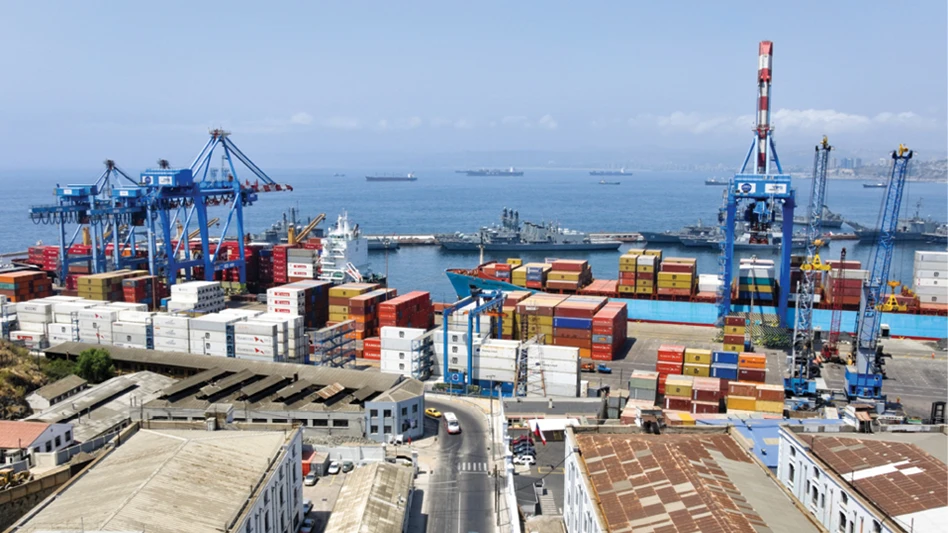

Chile is the world’s largest copper producer. Its 5.2 million metric tons of production last year top all other countries. A lesser-known fact, however, is that Chile also is the fifth-largest steel producer in Latin America behind Mexico, Brazil, Argentina and Colombia, producing around 1.3 million metric tons per year.
Juan Enrique Greibe, director of metallic purchases at Aceros AZA, based in Santigo, Chile, says his company is betting on the growing need for steel in the country.
Steel consumption rising
Chile is a net exporter of ferrous scrap. In 2022, the value of the country’s ferrous exports increased by 58 percent to $118.4 million from $74.5 million in the preceding year. The amount dwarfs the value of its ferrous scrap imports, which stood at $5.9 million in 2022. However, the trend is about to change with the increasing domestic consumption of scrap for steelmaking.
As with most developing countries, Chile’s steel usage is expanding and is expected to grow by 7.1 percent this year to 2.45 million metric tons from 2.29 million metric tons in 2022, according to the Chilean Steel Institute (ICHA). However, consumption has dropped from 3.29 million metric tons in 2021 because of stagnant investments in construction. Still, Greibe notes that the industry is bullish about a rebound in consumption in the near term.
“We must understand that steel is fundamental in a country’s development and must work tirelessly to produce it more sustainably given the impact of steelmaking on climate goals and economies globally,” Greibe says of steel’s vital role in Chile’s future.

Potential and opportunity
Chile’s steel industry largely is focused on blast furnace- (BF-) based steelmaking and iron production, even though Compania Siderurgica Huachipato (CSH), the largest steel producer in Chile, and its parent company, Grupo CAP, plan to produce roughly 300,000 metric tons of green steel by 2030. At this point, Aceros AZA is the only green steel producer in the country thanks to its electric arc furnace- (EAF-) based steelmaking. Its green steel output reaches 500,000 metric tons annually.
“In Chile, BF- and EAF-based steelmaking coexist, and each has a different set of challenges for sustainable steel production. At AZA, we have an EAF, which, in conjunction with other permanent investments, is meant to reduce our emissions. It allows us to produce steel aligned with the current environmental challenges,” Greibe says, adding that the company has one of the lowest carbon footprints within the global industry.
Its competitor, CSH, faced extended outages that began in February 2022 following its scheduled maintenance, as there were problems restarting production. CSH’s woes caused Chile’s steel production to fall by 14.2 percent in the first half of 2022 compared with the previous year. The company eventually decreased its 2022 finished steel production by 24 percent to 602,497 metric tons from 791,936 metric tons in the previous year.
Moreover, Grupo CAP relies heavily on iron production, and Aceros AZA is counting on its sustainable steel as its core advantage.
“The copper and steel industries are complimentary in that the steel market in Chile will grow in tandem with developments in the copper industry. Without a doubt, copper mining is one of the country’s economic engines, but steelmaking has been a relevant participant for a long time and has contributed to our country’s growth.” – Juan Enrique Greibe, Aceros AZA
Supply challenges
EAF-based steelmaking might be growing in Chile, but its main challenge remains the procurement of ferrous scrap to feed the furnaces.
“It is a challenge that we are working on,” Greibe says. “We are in a highly competitive market where new players are entering the market daily.” On the other hand, the country’s economic woes of the past few years have stalled ferrous scrap generation for the domestic market.
AZA has made steel in Chile for 70 years and has been producing low-carbon steel for about 30 years. The company sources approximately 600,000 metric tons of ferrous scrap from nearly 4,000 suppliers annually. Griebe notes the steelmaker consistently has increased its recycled ferrous material consumption in recent years, adding that 30 percent of the recycled ferrous material comes from industrial recyclers, while the rest are small businesses.
“The potential we have realized over the past few years through our network of recyclers is a good example of measures being taken within the country to improve domestic ferrous scrap procurement and making the large recycler network in the country a part of the circular economy model,” Greibe says.
However, even though the number of providers is robust, Greibe admits there is room to improve the scrap procurement process in Chile.
“Today, the industry is not only tasked with proving that circular economies, in particular recycling, is a fundamental business model for the world but must also promote improvements within the sector, from segregation at the production stages to traceability of origin to actual steelmaking,” he says.

Can copper and ferrous co-exist?
Given that copper is a key export and revenue driver for the country, the Chilean government’s support is focused on that sector, with a long-discussed mining royalty bill enacted in May.
Still, Greibe believes the copper and ferrous sectors not only can coexist but also can benefit from each other.
“The copper and steel industries are complementary in that the steel market in Chile will grow in tandem with developments in the copper industry,” he says. “Without a doubt, copper mining is one of the country’s economic engines, but steelmaking has been a relevant participant for a long time and has contributed to our country’s growth.”

Explore the Fall 2023 Scrap Recycling Issue
Check out more from this issue and find your next story to read.
Latest from Recycling Today
- Aqua Metals secures $1.5M loan, reports operational strides
- AF&PA urges veto of NY bill
- Aluminum Association includes recycling among 2025 policy priorities
- AISI applauds waterways spending bill
- Lux Research questions hydrogen’s transportation role
- Sonoco selling thermoformed, flexible packaging business to Toppan for $1.8B
- ReMA offers Superfund informational reports
- Hyster-Yale commits to US production





